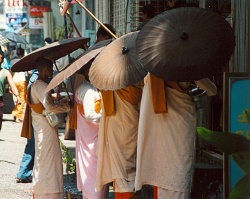Difference between revisions of "Thilashin"
| Line 3: | Line 3: | ||
[[File:YangonNuns.jpg|thumb|250px|Thilashin during alms round in Yangon, Myanmar (Burma).]] | [[File:YangonNuns.jpg|thumb|250px|Thilashin during alms round in Yangon, Myanmar (Burma).]] | ||
| − | They, like the [[Mae ji]] of neighbouring [[Thailand]] and the dasa sil mata of [[Sri Lanka]], occupy a position somewhere between that of an ordinary lay follower and an [[ordained]] [[Monk]]. However,they are treated more favourably than the [[Mae ji]], {{Wiki|being}} able to receive training, practice [[meditation]] and sit for the same qualification examinations as the [[monks]]. | + | They, like the [[Mae ji]] of neighbouring [[Thailand]] and the [[dasa]] sil mata of [[Sri Lanka]], occupy a position somewhere between that of an ordinary lay follower and an [[ordained]] [[Monk]]. However,they are treated more favourably than the [[Mae ji]], {{Wiki|being}} able to receive {{Wiki|training}}, [[practice]] [[meditation]] and sit for the same qualification examinations as the [[monks]]. |
Thilashins observe the [[Five Precepts#Ten Precepts|ten precepts]] and can be [[recognized]] by their pink [[robes]], shaven {{Wiki|head}}, orange or brown shawl and metal [[alms bowl]]. Thilashins would also go out on [[alms]] round on [[Uposatha]] days and receive uncooked {{Wiki|rice}} or [[money]]. | Thilashins observe the [[Five Precepts#Ten Precepts|ten precepts]] and can be [[recognized]] by their pink [[robes]], shaven {{Wiki|head}}, orange or brown shawl and metal [[alms bowl]]. Thilashins would also go out on [[alms]] round on [[Uposatha]] days and receive uncooked {{Wiki|rice}} or [[money]]. | ||
| Line 9: | Line 9: | ||
Thilashins are addressed with the honorifics "Sayalay" ([[Burmese]]: ဆရာလေး, [sʰəjàlé], [[meaning]] little [[teacher]]), and "Daw" (ဒေါ်, [dɔ̀]). These are used as honorifics to the [[Buddhist name]] given. | Thilashins are addressed with the honorifics "Sayalay" ([[Burmese]]: ဆရာလေး, [sʰəjàlé], [[meaning]] little [[teacher]]), and "Daw" (ဒေါ်, [dɔ̀]). These are used as honorifics to the [[Buddhist name]] given. | ||
| − | Thilashins can reside in either separate nunneries or in segregated [[monasteries]]. They do not have to look after the [[monks]], but may help cook for the [[monks]] if required. Although ranked lower than the [[monks]], they are not subservient to them. | + | Thilashins can reside in either separate [[nunneries]] or in segregated [[monasteries]]. They do not have to look after the [[monks]], but may help cook for the [[monks]] if required. Although ranked lower than the [[monks]], they are not subservient to them. |
==[[Ordination]]== | ==[[Ordination]]== | ||
| − | Thilashins are not [[ordained]] members of [[The Sangha]]. In many respects their lifestyle resembles that of a [[Bhikkhuni]], even to the extent of making a daily alms-round. However, they cannot obtain full [[ordination]] as the [[Bhikkhuni]] [[lineage]] [[died]] out. According to the [[Vinaya]], [[Bhikkhunis]] can be [[ordained]] only in the presence of a [[Bhikkhu]] and [[Bhikkhuni]]. | + | Thilashins are not [[ordained]] members of [[The Sangha]]. In many respects their lifestyle resembles that of a [[Bhikkhuni]], even to the extent of making a daily [[alms-round]]. However, they cannot obtain full [[ordination]] as the [[Bhikkhuni]] [[lineage]] [[died]] out. According to the [[Vinaya]], [[Bhikkhunis]] can be [[ordained]] only in the presence of a [[Bhikkhu]] and [[Bhikkhuni]]. |
There have been efforts by a few Thilashins to reinstate the [[Bhikkhuni]] [[lineage]], although there are reservations from the government and {{Wiki|general}} populace, including the women. | There have been efforts by a few Thilashins to reinstate the [[Bhikkhuni]] [[lineage]], although there are reservations from the government and {{Wiki|general}} populace, including the women. | ||
Latest revision as of 20:33, 8 March 2015
Thilashin (Burmese: သီလရှင်, pronounced: [θìla̰ʃɪ̀ɴ]; from Pali Sīla, lit. "Possessor of morality") is a Burmese Buddhist female lay renunciant. They are often mistakenly referred to as nuns, but are closest to Samaneri.
They, like the Mae ji of neighbouring Thailand and the dasa sil mata of Sri Lanka, occupy a position somewhere between that of an ordinary lay follower and an ordained Monk. However,they are treated more favourably than the Mae ji, being able to receive training, practice meditation and sit for the same qualification examinations as the monks.
Thilashins observe the ten precepts and can be recognized by their pink robes, shaven head, orange or brown shawl and metal alms bowl. Thilashins would also go out on alms round on Uposatha days and receive uncooked rice or money.
Thilashins are addressed with the honorifics "Sayalay" (Burmese: ဆရာလေး, [sʰəjàlé], meaning little teacher), and "Daw" (ဒေါ်, [dɔ̀]). These are used as honorifics to the Buddhist name given.
Thilashins can reside in either separate nunneries or in segregated monasteries. They do not have to look after the monks, but may help cook for the monks if required. Although ranked lower than the monks, they are not subservient to them.
Ordination
Thilashins are not ordained members of The Sangha. In many respects their lifestyle resembles that of a Bhikkhuni, even to the extent of making a daily alms-round. However, they cannot obtain full ordination as the Bhikkhuni lineage died out. According to the Vinaya, Bhikkhunis can be ordained only in the presence of a Bhikkhu and Bhikkhuni.
There have been efforts by a few Thilashins to reinstate the Bhikkhuni lineage, although there are reservations from the government and general populace, including the women.
